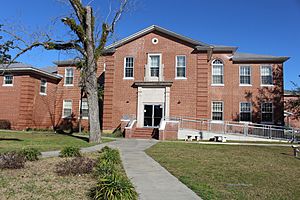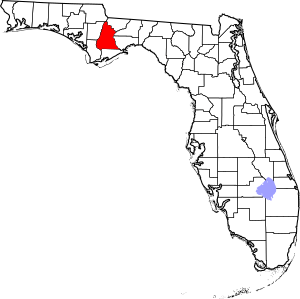Liberty County, Florida facts for kids
Quick facts for kids
Liberty County
|
|
|---|---|

Liberty County Courthouse
|
|

Location within the U.S. state of Florida
|
|
 Florida's location within the U.S. |
|
| Country | |
| State | |
| Founded | December 15, 1855 |
| Named for | Liberty |
| Seat | Bristol |
| Largest town | Bristol |
| Area | |
| • Total | 843 sq mi (2,180 km2) |
| • Land | 836 sq mi (2,170 km2) |
| • Water | 7.6 sq mi (20 km2) 0.9%% |
| Population
(2020)
|
|
| • Total | 7,974 |
| • Density | 10/sq mi (4/km2) |
| Time zone | UTC−5 (Eastern) |
| • Summer (DST) | UTC−4 (EDT) |
| Congressional district | 2nd |
Liberty County is a county located in the state of Florida. As of the 2020 census, it had 7,974 people living there. This makes it the county with the fewest people in all of Florida. Its main town and county seat is Bristol. Liberty County is also special because it is the only "dry county" in Florida. This means there are special rules about selling alcohol.
A big part of the county is covered by the Apalachicola National Forest.
Contents
History
Liberty County was created in 1855. It was named after the important American idea of liberty, which means freedom.
Geography
Liberty County covers a total area of about 843 square miles (2,183 square kilometers). Most of this area is land. Only a small part, about 7.6 square miles (20 square kilometers), is water. The Apalachicola River forms the western border of the county.
Neighboring Areas
Liberty County shares its borders with several other counties:
- Gadsden County - to the northeast
- Wakulla County - to the east
- Leon County - to the east
- Franklin County - to the south
- Gulf County - to the southwest
- Calhoun County - to the west
- Jackson County - to the northwest
Protected Natural Spaces
A part of the large Apalachicola National Forest is located within Liberty County. This forest is a protected area.
Population and People
| Historical population | |||
|---|---|---|---|
| Census | Pop. | %± | |
| 1860 | 1,457 | — | |
| 1870 | 1,050 | −27.9% | |
| 1880 | 1,362 | 29.7% | |
| 1890 | 1,452 | 6.6% | |
| 1900 | 2,956 | 103.6% | |
| 1910 | 4,700 | 59.0% | |
| 1920 | 5,006 | 6.5% | |
| 1930 | 4,067 | −18.8% | |
| 1940 | 3,752 | −7.7% | |
| 1950 | 3,182 | −15.2% | |
| 1960 | 3,138 | −1.4% | |
| 1970 | 3,379 | 7.7% | |
| 1980 | 4,260 | 26.1% | |
| 1990 | 5,569 | 30.7% | |
| 2000 | 7,021 | 26.1% | |
| 2010 | 8,365 | 19.1% | |
| 2020 | 7,974 | −4.7% | |
| 2023 (est.) | 7,706 | −7.9% | |
| U.S. Decennial Census 1790-1960 1900-1990 1990-2000 2010-2019 |
|||
Liberty County's population has changed over the years. In 1860, there were 1,457 people. The population grew steadily until 2010, when it reached 8,365. By the 2020 census, the population was 7,974.
The people living in Liberty County come from different backgrounds. In 2020, most residents were White. A significant number were Black or African American. There were also people who identified as Native American, Asian, or from other racial groups. Some people identified as being of mixed races. About 7% of the population identified as Hispanic or Latino.
Local Library
Liberty County is part of the Northwest Regional Library System. This library system also serves Gulf and Bay Counties. It provides books and other resources for the community.
Towns and Communities
Liberty County has one official town and several smaller communities.
Main Town
- Bristol - This is the county seat.
Designated Places
These are areas that the census bureau counts as specific places:
Other Communities
These are smaller, unincorporated communities within the county:
- Estiffanulga
- Orange
- Rock Bluff
- Telogia
- White Springs
- Wilma
- Woods
Transportation
Liberty County does not have any major Interstate highways or U.S. Highways. Instead, it relies on state roads for transportation.
 Florida State Road 20 is the main road that goes from west to east. It crosses the Apalachicola River and goes through Bristol and Hosford.
Florida State Road 20 is the main road that goes from west to east. It crosses the Apalachicola River and goes through Bristol and Hosford. Florida State Road 65 is the main road that goes from south to north. It runs from the Franklin/Liberty County line up to the Gadsden County line.
Florida State Road 65 is the main road that goes from south to north. It runs from the Franklin/Liberty County line up to the Gadsden County line. Florida State Road 12 travels from the southwest part of Liberty County towards Havana.
Florida State Road 12 travels from the southwest part of Liberty County towards Havana. Florida State Road 267 briefly runs next to State Road 20. It then heads north towards Quincy.
Florida State Road 267 briefly runs next to State Road 20. It then heads north towards Quincy.
Images for kids
See also
 In Spanish: Condado de Liberty (Florida) para niños
In Spanish: Condado de Liberty (Florida) para niños


